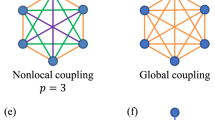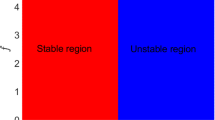Abstract
Nowadays, it is important to realize systems that can model the electrical activity of neurons taking into account almost all the properties of the intracellular and extracellular environment in which they are located. It is in this sense that we propose in this paper, the improved model of Hindmarsh–Rose (HR) which takes into account the fluctuation of the membrane potential created by the variation of the ion concentration in the cell. Considering the effect of the electric field that is produced on the dynamic behavior of neurons, the essential properties of the model such as equilibrium point and its stability, bifurcation diagrams, Lyapunov spectrum, frequency spectra, time series of the membrane potential and phase portraits are thoroughly investigated. We thus prove that Hopf bifurcation occurs in this system when the parameters are chosen appropriately. We also observe that by varying specific parameters of the electric field, the model presents a very rich and striking event, namely hysteresis phenomenon, which justifies the coexistence of multiple attractors. Besides, by applying a suitable sinusoidal excitation current, we prove that the neuron under electric field effect can present several important electrical activities including quiescent, spiking, bursting and even chaos. We propose the improved HR model under electric field effect (mHR) to study the finite-time synchronization between two neurons when performing synapse coupling across the membrane potential and the electric field coupling. As a result, we find that the synchronization between the two neurons is weakly influenced by the variation of the intensity of the electric field coupling while it is strongly impacted when the intensity of the synapse coupling is modified. From these results, it is obvious that the electric field can be another effective bridge connection to encourage the exchange and coding of the signal. Using the finite-time synchronization algorithm, we theoretically quantify the synchronization time between these neurons. Finally, Pspice simulations are presented to show the feasibility of the proposed model as well as that of the developed synchronization strategy.

















Similar content being viewed by others
References
Antonopoulos CG, Martinez EB, Baptista MS (2019) Evaluating performance of neural codes in model neural communication networks. Neural Netw 109:90–102
Bao BC, Jiang P, Wu HG, Hu FW (2015) Complex transient dynamics in periodically forced memristive chua’s circuit. Nonlinear Dyn 79:2333–2343
Bao BC, Hu A, Xu Q, Bao H, Hu W, Chen M (2018) AC-induced coexisting asymetric bursters in the improved Hindmarsh–Rose model. Nonlinear Dyn 92:1695
Boccaletti S, Latora V, Moreno Y, Chavez M et al (2006) Complex networks: structure and dynamics. Phys Rep 424:175–308
Boccaletti S, Bianconi G, Criado R, Wang Z, Zanin M et al (2014) The structure and dynamics of multilayer networks. Phys Rep 544:1–122
Cho YM, Rajamani R (1997) A systematic approach to adaptive observer synthesis for nonlinear systems. IEEE Trans Autom Control 42:534–537
Djeundam SRD, Yamapi R, Kofane TC, Azizalaoui MA (2013) Deterministic and stochastic bifurcations in the Hindmarsh–Rose neuronal model. Chaos 23:033125
Dong J, Zhang GJ, Xie Y, Yao H, Wang J (2014) Dynamic behavior analysis of fractional-order Hindmarsh–Rose neuronal model. Cogn Neurodyn 8:167–175
Estrada E (2012) The structure of complex networks: theory and applications. Oxford University Press, Oxford
Fitzhugh R (1961) Impulses and physiological states in theoretical models of nerve membrane. Biophys J 1:445
Fitzhugh R (1969) Mathematical models of excitation and propagation in nerve. In: Schwan HP (ed) Biological engineering. Mc Graw-Hill, New-York
Ge M, Jia Y, Xu Y, Yang L (2018) Mode transition in electrical activities of neuron driven by high and low frequency stimulus in the presence of electromagnetic induction and radiation. Nonlinear Dyn 91:515–523
González-Miranda JM (2007) Complex bifurcation structures in the Hindmarsh–Rose neuron model. Int J Bifurc Chaos 17:3071–3083
Gu HG, Pan BB, Chen GR, Duan LX (2014) Biological experimental demonstration of bifurcations from bursting to spiking predicted by theoretical models. Nonlinear Dyn 78:391–407
Guckenheimer J, Holmes P (1983) Nonlinear oscillations, dynamical systems and bifurcation of vector field. Springer, New York
Han C, Yu S, Wang GA (2015) Sinusoidally driven Lorenz system and circuit implementation. Math Prob Eng 2015:706902
Hindmarsh JL, Rose RM (1982) A model of the nerve impulse using two first-order differential equations. Nature 296:162–164
Hindmarsh JL, Rose RM (1984) A model of neuronal bursting using three coupled first order differential equations. Proc R Soc Lond B Biol Sci 221:87–102
Hodgkin AL, Huxley AF (1952) A quantitative description of membrane current and its application to conduction and excitation in nerve. J Physiol 117:500–544
Innocenti G, Genesio R (2009) On the dynamics of chaotic spiking–bursting transition in the Hindmarsh–Rose neuron. Chaos 19:023124
Innocenti G, Morelli A, Genesio R, Torcini A (2007) Dynamical phases of the Hindmarsh–Rose neuronal model: studies of the transition from bursting to spiking chaos. Chaos 17:043128
Jia C, Wang J, Deng B, Wei X, Che Y (2011) Estimating and adjusting abnormal networks with unknown parameters and topology. Chaos 21:013109
Kaslik E (2017) Analysis of two- and three-dimensional fractional-order Hindmarsh–Rose type neuronal models. Frac Calc Appl Anal 20:623–645
Kengne J, Chedjou JC, Kenne G, Kyamakya K, Kom GH (2012) Analog circuit implementation and synchronization of a system consisting of a van der Pol oscillator linearly coupled to a Duffing oscillator. Nonlinear Dyn 70:2163–2173
Kengne J, Jafari S, Njitacke ZT, Yousefi AK, Cheukem A (2017) Dynamic analysis and electronic circuit implementation of a novel 3D autonomous system without linear terms. Commun Nonlinear Sci Numer Simul. https://doi.org/10.1016/j.cnsns.2017.04.017
Khalil HK (2007) Nonlinear systems, 3rd edn. Prentice Hall, Upper Saddle River
Kivelä M, Arenas A, Barthelemy M, Gleeson JP, Moreno Y, Porter MA (2014) Multilayer networks. J Complex Netw 2:203–271
Kuznetsov YA (1998) Elements of applied bifurcation theory. Springer, New York
Letellier C, Denis F, Aguirre LA (2013) What can be learned from a chaotic cancer model ? J Theor Biol 322:7–16
Lopez MJ, Consegliere A, Garcia L, Lorenzo J (2015) Simulation and control of heart rhythm dynamics. Adv Biomed Res 1:509–516
Louodop P, Fotsin H, Kountchou M, Bowong S (2013) Finite-time synchronization of Lorenz chaotic systems: theory and circuits. IOP Sci 88:045002
Louodop P, Fotsin H, Kountchou M, Ngouonkadi LBM, Cerdeira HA, Bowong S (2014a) Finite-time synchronization of tunnel-diode-based chaotic oscillators. Phys Rev E 89:032921
Louodop P, Kountchou M, Fotsin H, Bowong S (2014b) Practical finite-time synchronization of Jerk systems: theory and experiment. Nonlinear Dyn 78:597
Lu L, Jia Y, Liu W, Yang L (2017) Mixed stimulus-induced mode selection in neural activity driven by high and low frequency current under electromagnetic radiation. Complexity 7628537:1–11
Lv M, Ma J (2016) Multiple modes of electrical activities in a new neuron model under electromagnetic radiation. Neurocomputing 205:375–381
Lv M, Wang CN, Ren GD, Ma J (2016) Model of electrical activity in a neuron under magnetic flow effect. Nonlinear Dyn 85:1479–1490
Ma J, Xu Y, Wang CN, Jin WY (2016) Pattern selection and self-organization induced by random boundary initial values in a neuronal network. Phys A 461:586–594
Ma J, Wu F, Wang C (2017) Synchronization behaviors of coupled neurons under electromagnetic radiation. Int J Mod Phys B 31:1650251
Ma J, Fuqiang W, Ahmed A, Jun T (2018) Crack synchronization of chaotic circuits under field coupling. Nonlinear Dyn. https://doi.org/10.1007/s11071-018-4307-x
Ma J, Zhang G, Hayat T, Ren GD (2019) Model electrical activity of neuron under electric field. Nonlinear Dyn 95:1585
Mondal A, Upadhyay RK, Ma J et al (2019) Bifurcation analysis and diverse firing activities of a modified excitable neuron model. Cogn Neurodyn 13:393–407
Morris C, Lecar H (1981) Voltage oscillations in the barnacle giant muscle fiber. Biophys J 35:193–213
Negou AN, Kengne J (2018) Dynamic analysis of a unique jerk system with a smoothly adjustable symmetry and nonlinearity: reversals of period doubling, offset boosting and coexisting bifurcations. Int J Electron Commun (AEÜ) 90:1–19
Ngouonkadi EB, Fotsin HB, Louodop F (2014) Implementing a memristive Van der Pol oscillator coupled to a linear oscillator: synchronization and application to secure communication. IOP Sci 89:035201
Ngouonkadi EBM, Fotsin HB, Fotso PL, Tamba VK, Cerdeira HA (2016) Bifurcations and multistability in the extended Hindmarsh–Rose neuronal oscillator. Chaos, Solitons Fractals 85:151–163
Njitacke ZT, Kengne J (2018) Complex dynamics of a 4D Hopfield neural networks (HNNs) with a nonlinear synaptic weight: coexistence of multiple attractors and remerging Feigenbaum trees. Int J Electron Commun (AEÜ) 93:242–252
Njitacke ZT, Kengne J, Negou AN (2017) Dynamical analysis and electronic circuit realization of an equilibrium free 3D chaotic system with a large number of coexisting attractors. Optik 130:356–364
Njitacke ZT, Kengne J, Fonzin FT, Leutcha PB, Fotsin HB (2018) Dynamical analysis of a novel 4-neurons based Hopfield neural network: emergences of antimonotonicity and coexistence of multiple stable states. Int J Dyn Control. https://doi.org/10.1007/s40435-019-00509-w
Paden Brad E, Shankar Sastry (1987) A calculus for computing filippov’s differential inclusion with application to the variable structure control of robot. IEEE Trans Circuit Systems 35:73–82
Panahi S, Aram Z, Jafari S, Ma M, Sprott JC (2017) Modeling of epilepsy based on chaotic artificial neural network. Chaos Solitons Fractals 105:150–156
Parastesh F, Azarnoush H, Jafari S et al (2019) Synchronizability of two neurons with switching in the coupling. Appl Math Comput 350:217–223
Perc M (2009) Optimal spatial synchronization on scale-free networks via noisy chemical synapses. Biophys Chem 141:175–179
Ren G, Xu Y, Wang C (2017a) Synchronization behavior of coupled neuron circuits composed of memristors. Nonlinear Dyn 88:893–901
Ren GD, Zhou P, Ma J, Cai N, Alsaedi A, Ahmad B (2017b) Dynamical response of electrical activities in digital neuron circuit driven by autapse. Int J Bifurc Chaos 27:1750187
Ren G, Xue Y, Li Y, Ma J (2019) Field coupling benefits signal exchange between Colpitts systems. Appl Math Comput 342:45–54
Rigatos G, Wira P, Melkikh A (2019) Nonlinear optimal control for the synchronization of biological neurons under time-delays. Cogn Neurodyn 13:89–103
Shi X, Wang Z (2012) Adaptive synchronization of time delay Hindmarsh–Rose neuron system via self-feedback. Nonlinear Dyn 69:21472153
Spitzer NC (2006) Electrical activity in early neuronal development. Nature 444:707–712
Strogatz SH, Friedman M, Mallinckrodt AJ, Mckay S (1994) Nonlinear dynamics and chaos: with applications to physics, biology, chimestry and engineering. Comput Phys 8(5):532
Uhhaas PJ, Singer W (2006) Neural synchrony in brain disorders: relevance for cognitive dysfunctions and pathophysiology. Neuron 52:155–168
Wang Z, Shi X (2020) Electric activities of time delay memristive neuron disturbed by Gaussian white noise. Cogn Neurodyn 14:115–124
Wiggins S (1990) Introduction to applied nonlinear dynamical systems and chaos. Springer, New York
Wolf A, Swift JB, Swinney HL, Wastano JA (1985) Determining Lyapunov exponents from time series. Phys D 16:285–317
Wouapi KM, Fotsin HB, Feudjio KF, Njitacke ZT (2019) Hopf bifurcation, offset boosting and remerging Feigenbaum trees in an autonomous chaotic system with exponential nonlinearity. SN Appl Sci 1:1715
Wu KJ, Luo TQ, Lu HW, Wang Y (2016) Bifurcation study of neuron firing activity of the modified Hindmarsh–Rose model. Neural Comput Appl 27:739–747
Wu F, Ma J, Zhang G (2019) A new neuron model under electromagnetic field. Appl Math Comput 347:590–599
Xu Q, Zhang QL, Bao BC, Hu YH (2017) Non-autonomous second-order memristive chaotic circuit. IEEE Access 5:21039–21045
Zuppa LA, Hernandez CC, Bustos AYA (2002) Finite synchronization of Lorenz-based chaotic systems. www.wseas.us/e-library/conferences/mexico2002/papers/249.pdf. Accessed 4 April 2017
Author information
Authors and Affiliations
Corresponding author
Additional information
Publisher's Note
Springer Nature remains neutral with regard to jurisdictional claims in published maps and institutional affiliations.
Rights and permissions
About this article
Cite this article
Wouapi, K.M., Fotsin, B.H., Louodop, F.P. et al. Various firing activities and finite-time synchronization of an improved Hindmarsh–Rose neuron model under electric field effect. Cogn Neurodyn 14, 375–397 (2020). https://doi.org/10.1007/s11571-020-09570-0
Received:
Revised:
Accepted:
Published:
Issue Date:
DOI: https://doi.org/10.1007/s11571-020-09570-0




